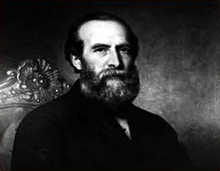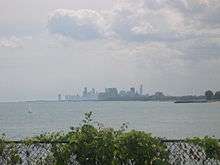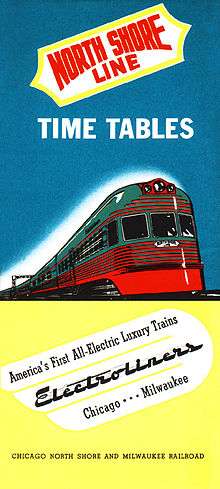North Shore (Chicago)
.svg.png)
The North Shore consists of many affluent suburbs north of Chicago, Illinois, bordering the shores of Lake Michigan. These communities fall within suburban Cook County and Lake County. The North Shore's membership is often a topic of debate, and is sometimes expanded to include other affluent Chicago suburbs which do not border Lake Michigan. However, Evanston, Wilmette, Kenilworth, Winnetka, Glencoe, Highland Park, Lake Forest, and Lake Bluff are generally considered to be the core members of the North Shore, as all are affluent communities that border the lake just north of Chicago. Other suburbs such as Glenview, Northbrook, Deerfield, Bannockburn, and Northfield are often considered to be a part of the North Shore, but do not border Lake Michigan.
History

Europeans settled the area sparsely after an 1833 treaty with local Native Americans. The region began to be developed into towns following the opening of Northwestern University in Evanston in 1855 and the founding of Lake Forest College two years later, and the construction and launch of railroads serving the colleges and their towns.
Electric rail lines were also run from Chicago, parallel to steam commuter lines, and streetcars flourished throughout the suburbs from Evanston on north. The North Shore today is noteworthy for being one of the few remaining agglomerations of streetcar suburbs in the United States.
This area became popular with the affluent wanting to escape urban life, beginning after the Great Chicago Fire, and grew rapidly before and just after World War II with a growing Jewish population migrating out of various neighborhoods in Chicago. The major Jewish suburban communities include Evanston, Skokie, Glencoe and Highland Park. Jews, however, were barred from Kenilworth and Lake Forest. The number of Jews in the north suburbs increased to 40% by the early 1960s. It is notable, too, that at this point in time most of these north suburbs were almost entirely white. One informal 1967 poll by mostly white residents of the North Shore seeking to promote open housing suggested that of 2,000 real estate listings, only 38 were open to African-Americans.[2]
Communities and their years of settlement and incorporation
Source:[3]
| Community | Year of settlement | Year of incorporation | Population | |
|---|---|---|---|---|
| 1 | Lake Forest | 1834 (c.) | 1861 | 21,300 |
| 2 | Glencoe | 1835 | 1869 | 8,723 |
| 3 | Winnetka | 1836 | 1869 | 12,419 |
| 4 | Lake Bluff | 1836 | 1895 | 6,056 |
| 5 | Wilmette | 1840 | 1872 | 27,087 |
| 6 | Highland Park | 1847 | 1869 | 29,763 |
| 7 | Evanston | 1853 | 1863 | 74,486 |
| 8 | Kenilworth | 1889 | 1896 | 2,494 |
Socioeconomics and culture

Today the North Shore remains one of the most affluent and highly educated areas in the United States. Seven of its communities are in the top quintile of U.S. household income, and five of those (Lake Forest, Glencoe, Kenilworth, Winnetka, Highland Park) are in the top 5 percent. From Evanston to Lake Bluff, only Highwood falls below the national median.
The North Shore is also the home of the Ravinia Festival, a historic outdoor music theater in Highland Park, Illinois. The Ravinia Festival, originally conceived as a weekend destination on the CNS&M line, is now a popular destination on the Metra Union Pacific North Line commuter rail, the North Shore Line's former competitor.
The abandoned right-of-way of the North Shore Line still serves Ravinia as the Green Bay Trail, a popular rails-to-trails bicycle path that begins in Wilmette and runs north all the way to the Illinois Beach State Park in Zion.
Origin and definition of term
.jpg)
Early histories of Chicago do not use the term North Shore. It began to come into use in the early 1880s and by 1889, with the creation of the North Shore Improvement Association, the name was officially established.[5] In 1890 Joseph Sears used the term several times in a brochure that was written to promote the newly-forming community of Kenilworth.[6] It is believed to have come into widespread use following the establishment in 1891 of the Waukegan & North Shore Rapid Transit Company, which in 1916 following reorganization was renamed the Chicago North Shore and Milwaukee Railroad ("CNS&M"). This railway ran along Lake Michigan's western shore between Chicago and Milwaukee. The "Shore Line Route" of the CNS&M until 1955 served, from south to north, the Illinois communities of Chicago, Evanston, Wilmette, Kenilworth, Winnetka, Glencoe, Highland Park, Highwood, Fort Sheridan, Lake Forest, Lake Bluff, North Chicago, Waukegan, Zion, and Winthrop Harbor as well as Kenosha, Racine and Milwaukee in Wisconsin. The line was popularly referred to, including in the railroad's own brochures and timetables, as the "North Shore Line." After 1924 the "Skokie Valley" line of the CNS&M opened land further west to the North Shore.
Meanwhile, in 1906, the Sanitary District of Chicago platted the "North Shore Channel" of the sanitary canal from the Chicago River, through Evanston and Wilmette to Lake Michigan.[7]
While the CNS&M ran from Chicago all the way to Milwaukee, the term "North Shore" today typically refers only to the communities between Lake Bluff and Chicago. Michael Ebner's scholarly Creating Chicago's North Shore: A Suburban History, one of the most thorough studies of the area, covers eight suburbs along the lake: Evanston, Wilmette, Kenilworth, Winnetka, Glencoe, Highland Park, Lake Forest, and Lake Bluff.[8] In their North Shore Chicago: Houses of the Lakefront Suburbs, 1890-1940, Cohen and Benjamin include not only those eight suburbs but also "the tiny city of Highwood" which is slightly inland, just north of Highland Park.[9]
The Greater North Shore

Subsequent to the more general use of the term North Shore for the above suburbs, and the term's association with those towns' desirable socioeconomic characteristics, it became common for businesses in numerous nearby inland Chicago suburbs in the Maine, New Trier, Niles and Northfield Townships and in southern Lake County, Illinois to name themselves "North Shore," and for real estate and other marketers to use the term for non-North Shore communities from time to time. The former North Shore magazine had special advertising editions not only for Evanston, Winnetka, Lake Forest, and Lake Bluff but also for Glenview, Northbrook, Barrington, Deerfield, Bannockburn, and Riverwoods.[10] Chicago's North Shore Convention & Visitors Bureau's markets the City of Evanston and the Villages of Skokie, Glenview, Northbrook and Winnetka.[11] More recently, a community newspaper known as "What's Happening" began mailing out its publication to what it characterizes as the "16 affluent North Shore suburbs": Bannockburn, Buffalo Grove, Deerfield, Fort Sheridan, Glencoe, Glenview, Highland Park, Kenilworth, Libertyville, Lincolnshire, Northbrook, Northfield, Riverwoods, Vernon Hills, Wilmette, and Winnetka.[12] Overall, the general usage of the term, North Shore, applies to the following suburbs: Bannockburn, Deerfield, Evanston, Fort Sheridan, Glencoe, Glenview, Golf, Highland Park, Highwood, Kenilworth, Lake Bluff, Lake Forest, Libertyville, Northbrook, Northfield, Riverwoods, Wilmette, and Winnetka. This geographic area favored by marketeers extends from Chicago’s northern boundary into southern Lake County and from Lake Michigan to O’Hare Airport.[13]
Education
Mostly the Central Suburban League public high schools cater to the North Shore. The Central Suburban League is an IHSA-recognized high school extracurricular conference comprising 12 public schools located in the northern suburbs of Chicago. Comprising 12 relatively large high schools, it is among the larger high school conferences (by student population) in Illinois.[14] The Central Suburban League high schools include: Deerfield High School (Deerfield, IL), Evanston Township High School (Evanston, IL), Glenbrook North High School (Northbrook, IL), Glenbrook South High School (Glenview, IL), Highland Park High School (Highland Park, IL), Maine South High School (Park Ridge, IL), Maine East High School (Park Ridge, IL), Maine West High School (Des Plaines, IL), New Trier High School (Winnetka, IL), Niles West High School (Skokie, IL), Niles North High School (Skokie, IL), and Vernon Hills High School (Vernon Hills, IL).
Lake Forest High School, Libertyville High School, and Stevenson High School, are in the North Suburban Conference. The Lake Forest High School district serves Lake Forest and Lake Bluff, while the Stevenson High School district serves Lincolnshire and most of Buffalo Grove. Stevenson also takes in students from smaller parts of other North Shore suburbs such as Deerfield, Mettawa, Lake Forest, Riverwoods, Vernon Hills, as well as reaching into the far Northwest Suburbs such as Hawthorn Woods, Kildeer, Lake Zurich, Mundelein, and Long Grove.
Wheeling High School serves most of Wheeling, Illinois which is in the Mid-Suburban League.
Oakton Community College serves the same district as the Central Suburban League, with campuses in Des Plaines and Skokie. College of Lake County serves the Lake County suburbs of the North Shore, with its campus in Grayslake, Illinois. Harper College serves Wheeling with its campus in Palatine, Illinois.
There are also a variety of private schools throughout the North Shore suburbs.
Films and television set or filmed on the North Shore
This area received much exposure in the 1980s as the setting of many teen films, particularly those of writer/director John Hughes, who grew up in Northbrook and attended Glenbrook North High School. The most notable films through the years are:
- Ordinary People (1980) was filmed in Highwood, Highland Park, Lake Bluff, Lake Forest, Northbrook and Wilmette.
- Class (1983) was filmed at Lake Forest College in Lake Forest and other locations in Chicago.
- Risky Business (1983) was filmed in Deerfield, Highland Park, Skokie, Winnetka and Wilmette, in addition to Lake Shore Drive.
- Sixteen Candles (1984) was filmed in Evanston, Glencoe, Highland Park, Skokie and Winnetka.
- The Breakfast Club (1985) was filmed mostly at Maine North High School in Des Plaines, with additional scenes filmed at Maine West High School in Des Plaines, Maine South High School in Park Ridge, and Glenbrook North High School in Northbrook.
- Weird Science (1985) was filmed in Highland Park, Skokie and Northbrook.
- Ferris Bueller's Day Off (1986) was filmed in Highland Park, Winnetka, Northbrook, Lake Forest, Des Plaines, and Glencoe, in addition to many locations in Chicago itself, with scenes filmed at Glenbrook North, New Trier High School and Maine North High School.
- She's Having a Baby (1988) was filmed in Winnetka, Skokie, Glencoe and Northbrook in addition to many locations in Chicago itself.
- Uncle Buck (1989) was filmed in Evanston, Glencoe, Highland Park, Lake Forest, Northbrook, Northfield, Skokie, Wilmette and Winnetka, in addition to many locations in Chicago itself.
- Home Alone (1990) was filmed in Lake Forest, Winnetka, Wilmette, Highland Park and Evanston, and featured a Maine South High School letterman's jacket.
- Home Alone 2 (1992)
- Chain Reaction (1996) has scenes at a famous Lake Bluff estate and was largely shot in downtown Chicago
- Home Alone 3 (1997)
- My Best Friend's Wedding (1997) has scenes at Cuneo Museum & Gardens and various Chicago locations
- Shattered Glass (2003)
- Cheaper by the Dozen (2003)
- Ocean's 12 (2004) has filmed in the Chicago area and has a few North Shore filming locations: the home of Danny and Tess Ocean is in Winnetka, in the 600 block of Walden.[15] Dimitrios Jewelers in Lake Forest is also in one of the scenes.[16] One of the opening scenes in which Virgil Malloy is having his rehearsal dinner where Terry Benedict shows up was filmed in Lincolnwood, Illinois.
- Surviving Christmas (2004)
- Mean Girls (2004) takes place at the fictional North Shore High School, which in the film is located in Evanston. The affluent North Shore High School is based on New Trier Township High School in nearby Winnetka.[17] While the movie tacked the Old Orchard Shopping Center name on the mall in the film, nothing from this movie was filmed on the North Shore.
- Derailed (2005)
- The Weather Man (2005) was filmed in Evanston and Skokie in addition to many locations in Chicago itself.
- The League (2009–2015) was set in Winnetka, with the main characters having attended the fictional North Winnetka High School.
- Source Code (2011)
- Contagion (2011) Matt Damon filmed scenes at a private home in the 500 block of Woodlawn Avenue in Glencoe.[18]
Places of interest

- Northwestern University, Evanston
- North Shore Center for the Performing Arts, Skokie
- Ravinia park in Highland Park hosts the Ravinia Festival each year.
- Chicago Botanic Garden, Glencoe
- Bahá'í Temple, Wilmette
- Ryan Field stadium, Evanston, is the home field of the Northwestern University Wildcats football team.
- Illinois Holocaust Museum and Education Center, Skokie
- Kohl Children's Museum, Glenview
- The Crow Island School building, Winnetka, designed by the Finnish architect Eero Saarinen in 1939-40.[19]
- Ward Willits House, Highland Park, designed by Frank Lloyd Wright in 1901.
- North Point Marina, Winthrop Harbor.
- Rivers Casino, Des Plaines.
- Westfield Old Orchard Shopping Center, Skokie.
- The Nature preserve Illinois Beach State Park, Zion.
- Northbrook Court, Northbrook
- Illinois Beach State Park
- Grosse Point Light, Evanston.
- Pickwick Theatre, Park Ridge.
- The First McDonald's, Des Plaines.
- Zion Nuclear Power Station.
- Fort Sheridan, Highwood.n
- Lake Forest College, Lake Forest.
References
- ↑ Ebner, Michael H. (1989). Creating Chicago's North Shore. Chicago: University of Chicago Press. p. 22. ISBN 0-226-18205-3.
- ↑ "Few Homes Found Open to Negro Buyer". Chicago Tribune. 15 June 1967.
- ↑ Grossman, James R.; Ann Durkin Keating; Janice L. Reiff (2004). The Encyclopedia of Chicago. Chicago: University of Chicago Press. pp. 285, 338, 380, 444–445, 452, 455, 881, 882–3. ISBN 0-226-31015-9. Retrieved 2011-11-15.
- ↑ White, Marian A. (1910). The Book of the North Shore. Chicago: J. Harrison White. p. 106.
- ↑ Grossman, Ron (June 28, 1988). "North Shore Lore". The Chicago Tribune.
- ↑ Kenilworth: The Modern Suburban Home. Chicago. 1890.
- ↑ "North Shore Sanitary Canal". Retrieved 2010-11-19.
- ↑ Ebner, Michael H. (1989). Creating Chicago's North Shore. Chicago: University of Chicago Press. p. xvii. ISBN 0-226-18205-3.
- ↑ Cohen, Stuart; Susan Benjamin (2005). North Shore Chicago: Houses of the Lakefront Suburbs, 1890-1940. New York: Acanthus Press. p. 44. ISBN 0-926494-26-0.
- ↑ North Shore magazine, accessed 15 Dec 2009.
- ↑ Chicago's North Shore Convention & Visitors Bureau, March 2012.
- ↑ "What's Happening! History"., accessed 21 Jul 2011.
- ↑ "North Shore Senior Center"., accessed 18 Mar 2012.
- ↑ 2008–09 official school enrollments
- ↑ http://articles.chicagotribune.com/2004-12-09/news/0412090432_1_danny-ocean-linus-caldwell-ocean-s-twelve
- ↑ http://articles.chicagotribune.com/2004-12-09/news/0412090432_1_danny-ocean-linus-caldwell-ocean-s-twelve
- ↑ http://www.imdb.com/title/tt0377092/trivia
- ↑ http://www.triblocal.com/glencoe/2010/11/29/matt-damon-in-glencoe/
- ↑ GreatBuildings.com. "Crow Island School". Retrieved 2011-11-09.
Further reading
- Berger, Philip. Highland Park: American Suburb at Its Best: An Architectural and Historical Survey. Chicago: Chicago Review Press, 1983
- Bushnell, George D. Wilmette: A history. Wilmette: The Village of Wilmette, 1984
- Cohen, Stuart Earl and Susan S. Benjamin. North Shore Chicago: Houses of the Lakefront Suburbs, 1890-1940. New York: Acanthus Press, 2004
- Dickinson, Lora Townsend. The Story of Winnetka. Winnetka: Winnetka Historical Society, 1956
- Ebner, Michael H. Creating Chicago’s North Shore. Chicago: The University of Chicago Press, 1988
- Foster, Clyde D. Evanston's Yesterdays: Stories of Early Evanston and Sketches of Some of Its Pioneers. Evanston: Privately printed, 1956
- White, Marian A. (1910). "The Book of the North Shore". J. Harrison White. Retrieved 2011-11-09.
- White, Marian A. (1911). "The Second Book of the North Shore". J. Harrison White. Retrieved 2011-11-09.
- Townsend, Frank with forward by Patsy Ritter. Lake Bluff Illinois; a Pictorial History. Lake Bluff: Village of Lake Bluff Centennial Committee, 1995
- Waukegan Historical Society. Images of American - Waukegan, Illinois.Chicago: Arcadia Press, 2000
